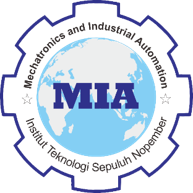The Effect of Build Orientation on Liquid Absorption and Wear of 3D-Printed Denture Materials
Abstract
Up till now, denture has been widely used for resolving dental problems, especially those due to attrition. The attrition of tooth enamel could lead to wear and lowering the functions of normal teeth. So far, denture is made conventionally by using heat curing method in a mold. However, the complex geometries of teeth and oral cavity has led to the use of the more advanced techniques, such as additive manufacturing. In this research, the denture material fabricated by using digital light processing (DLP) additive manufacturing was studied in term of their liquid absorption capability and wear behavior. The specimen was printed with three build orientations, namely 0°/180°, 90°/90°, and 45°/135°. These are the degree between printing direction against sliding direction. An immersion and wear test were carried out in artificial saliva liquid. The result showed the lowest weight gain and dimensional change in the specimens printed with 90°/90° and 45°/135°. Meanwhile, the specimens prepared with build orientation of 0°/180° or printed with layer parallel to sliding direction demonstrated the smallest value of wear factor, indicating a better wear resistance compared to the others. A visual examination of the worn surface indicated delamination, abrasion and cracking as the possible wear mechanisms of the printed denture materials.
Keywords
Full Text:
PDFReferences
S. H. Ahn, J. Lee, S. A. Park, and W. D. Kim, “Three-dimensional bio-printing equipment technologies for tissue engineering and regenerative medicine,” Tissue Eng. Regen. Med., vol. 13, no. 6, pp. 663–676, 2016.
A. Bandyopadhyay and B. Heer, “Additive manufacturing of multi-material structures,” Mater. Sci. Eng. R Reports, vol. 129, pp. 1–16, 2018.
S. A. M. Tofail, E. P. Koumoulos, A. Bandyopadhyay, S. Bose, L. O’Donoghue, and C. Charitidis, “Additive manufacturing: scientific and technological challenges, market uptake and opportunities,” Mater. Today, vol. 21, no. 1, pp. 22–37, 2018.
ISO/ASTM, “Additive Manufacturing - General Principles Terminology (ASTM52900),” Rapid Manuf. Assoc., pp. 10–12, 2013.
V. Yadav et al., “3D printed hollow microneedles array using stereolithography for efficient transdermal delivery of rifampicin,” Int. J. Pharm., vol. 605, p. 120815, 2021.
A. Triacca, G. Pitzanti, E. Mathew, B. Conti, R. Dorati, and D. A. Lamprou, “Stereolithography 3D printed implants: A preliminary investigation as potential local drug delivery systems to the ear,” Int. J. Pharm., vol. 616, p. 121529, 2022.
G. Flamourakis, A. Kordas, M. Papageorgiou, V. Pateraki, M. Farsari, and A. Ranella, “High-resolution lightweight and multifunctional 3D printed scaffolds for cell studies,” Results Mater., vol. 18, p. 100393, 2023.
R. Osman, N. Alharbi, and D. Wismeijer, “Build Angle: Does It Influence the Accuracy of 3D-Printed Dental Restorations Using Digital Light-Processing Technology?,” Int. J. Prosthodont., vol. 30, no. 2, pp. 182–188, 2017.
W. S. Lin, B. T. Harris, J. Pellerito, and D. Morton, “Fabrication of an interim complete removable dental prosthesis with an in-office digital light processing three-dimensional printer: A proof-of-concept technique,” J. Prosthet. Dent., vol. 120, no. 3, pp. 331–334, 2018.
G. S. Park, S. K. Kim, S. J. Heo, J. Y. Koak, and D. G. Seo, “Effects of printing parameters on the fit of implant-supported 3D printing resin prosthetics,” Materials (Basel)., vol. 12, no. 16, 2019.
A. Carvalho, P. Pinto, S. Madeira, F. S. Silva, O. Carvalho, and J. R. Gomes, “Tribological Characterization of Dental Restorative Materials,” Biotribology, vol. 23, p. 100140, 2020.
E. Emami, R. F. de Souza, M. Kabawat, and J. S. Feine, “The Impact of Edentulism on Oral and General Health.International Journal f Dentistry,” Int. J. Dent., vol. 2013, p. 7, 2013.
H. Tamura, “Flexural Strength of CAD/CAM Denture Base Materials: Systematic Review and Meta-analysis of In-vitro Studies,” vol. 8, no. 831, pp. 34–37, 2005.
A. Della Bona, V. Cantelli, V. T. Britto, K. F. Collares, and J. W. Stansbury, “3D printing restorative materials using a stereolithographic technique: a systematic review,” Dent. Mater., vol. 37, no. 2, pp. 336–350, 2021.
A. Riwandy and I. Tanti, “Marginal fit comparison of conventional and CAD/CAM techniques of PMMA temporary crown 1,” Indones. J. Prosthodont., vol. 4, no. 2, pp. 79–83, 2023.
I. A. Tsolakis, S. Gizani, N. Panayi, G. Antonopoulos, and A. I. Tsolakis, “Three-Dimensional Printing Technology in Orthodontics for Dental Models: A Systematic Review,” Children, vol. 9, no. 8, pp. 1–15, 2022.
W. Piedra-Cascón, V. R. Krishnamurthy, W. Att, and M. Revilla-León, “3D printing parameters, supporting structures, slicing, and post-processing procedures of vat-polymerization additive manufacturing technologies: A narrative review,” J. Dent., vol. 109, 2021.
A. A. Alshamrani, R. Raju, and A. Ellakwa, “Strength and Hardness of a 3D-Printed Resin,” Biomed Res. Int., vol. 2022, 2022.
R. Brighenti, L. Marsavina, M. P. Marghitas, M. Montanari, A. Spagnoli, and F. Tatar, “The effect of process parameters on mechanical characteristics of specimens obtained via DLP additive manufacturing technology,” Mater. Today Proc., vol. 78, pp. 331–336, 2023.
Y. A. Al-Dulaijan et al., “Comparative Evaluation of Surface Roughness and Hardness of 3D Printed Resins,” Materials (Basel)., vol. 15, no. 19, pp. 1–13, 2022.
T. Jiang et al., “Study of Forming Performance and Characterization of DLP 3D Printed Parts,” Materials (Basel)., vol. 16, no. 10, 2023.
B. Arifvianto et al., “Sliding wear characteristics of FDM-processed polylactic-acid in bovine blood serum,” J. Mech. Eng. Sci., vol. 13, no. 4, pp. 5848–5861, 2019.
A. Grymak, M. T. Tieh, A. H. X. Yang, and J. J. E. Choi, “Development of predictive algorithms for the wear resistance of denture teeth materials,” J. Mech. Behav. Biomed. Mater., vol. 144, p. 105984, 2023.
K. E. Ojaomo, S. Samion, and M. Z. M. Yusop, “Nano Bio-Lubricant as a Sustainable Trend in Tribology towards Environmental Stability: Opportunities and Challenges,” Evergreen, vol. 11, no. 1, pp. 253–274, 2024.
J. Zheng, Z. R. Zhou, J. Zhang, H. Li, and H. Y. Yu, “On the friction and wear behaviour of human tooth enamel and dentin,” Wear, vol. 255, no. 7–12, pp. 967–974, 2003.
A. Wang, D. C. Sun, and C. Stark, “Wear mechanisms of UHMWPE in total joint replacements,” vol. 183, pp. 241–249, 1995.
B. T. Prayoga, S. Suyitno, and R. Dharmastiti, “The wear behavior of UHMWPE against surface modified CP-titanium by thermal oxidation,” Tribol. Ind., vol. 38, no. 4, pp. 543–551, 2016.
T. Vila, A. M. Rizk, A. S. Sultan, and M. A. Jabra-Rizk, “The power of saliva: Antimicrobial and beyond,” PLoS Pathog., vol. 15, no. 11, pp. 10–16, 2019.
S. Fatima et al., “Composition and Function of Saliva: a Review,” World J. Pharm. Pharm. Sci., vol. 9, no. 6, pp. 1552–1567, 2020.
D. Łysik, K. Niemirowicz-Laskowska, R. Bucki, G. Tokajuk, and J. Mystkowska, “Artificial saliva: Challenges and future perspectives for the treatment of xerostomia,” Int. J. Mol. Sci., vol. 20, no. 13, 2019.
H. Hadjieva, M. Dimova, E. Hadjieva, and S. Todorov, “CHANGES IN THE VERTICAL DIMENSION OF OCCLUSION DURING DIFFERENT PERIODS OF COMPLETE DENTURE WEAR - a comparative study,” J. IMAB - Annu. Proceeding (Scientific Pap., vol. 20, no. 3, pp. 546–549, 2014.
M. Dimova-Gabrovska, D. Dimitrova, and V. Mitronin, “Removable Prosthetic Treatment in children,” J IMAB, vol. 24, no. 3, pp. 2172–2176, 2018.
M. Dimitrova et al., “Evaluation of Water Sorption and Solubility of 3D-Printed, CAD/CAM Milled, and PMMA Denture Base Materials Subjected to Artificial Aging,” J. Compos. Sci., vol. 7, no. 8, 2023.
F. Alam, V. R. Shukla, K. M. Varadarajan, and S. Kumar, “Microarchitected 3D printed polylactic acid (PLA) nanocomposite scaffolds for biomedical applications,” J. Mech. Behav. Biomed. Mater., vol. 103, p. 103576, 2020.
Z. Wu et al., “Nanoporosity improved water absorption, in vitro degradability, mineralization, osteoblast responses and drug release of poly(Butylene succinate)-based composite scaffolds containing nanoporous magnesium silicate compared with magnesium silicate,” Int. J. Nanomedicine, vol. 12, pp. 3637–3651, 2017.
M. A. Suhot, M. Z. Hassan, S. A. Aziz, and M. Y. Md Daud, “Recent progress of rice husk reinforced polymer composites: A review,” Polymers (Basel)., vol. 13, no. 15, 2021.
M. J. Sheykh, A. Tarmian, K. Doosthoseini, and A. abdulkhani, “Wear resistance and friction coefficient of nano-SiO2 and ash-filled HDPE/lignocellulosic fiber composites,” Polym. Bull., vol. 74, no. 11, pp. 4537–4547, 2017.
S. H. Shin, R. M. Doh, J. H. Lim, J. S. Kwon, J. S. Shim, and J. E. Kim, “Evaluation of dimensional changes according to aging period and postcuring time of 3d-printed denture base prostheses: An in vitro study,” Materials (Basel)., vol. 14, no. 20, 2021.
N. Myshkin and A. Kovalev, “Adhesion and surface forces in polymer tribology—A review,” Friction, vol. 6, no. 2, pp. 143–155, 2018.
V. Kapps, C. M. Almeida, R. M. Trommer, C. A. Senna, and M. M. Maru, “Scatter in delamination wear tests of tribopair materials used in articulated implants,” Tribol. Int., vol. 133, pp. 172–181, 2019.
I. Hager, M. Maroszek, K. Rafał, and L. Dvorkin, “Interlayer Bond Strength Testing in 3D-Printed Mineral,” 2022.
DOI: http://dx.doi.org/10.12962%2Fj23378557.v11i1.a21583
Refbacks
- There are currently no refbacks.
This work is licensed under a Creative Commons Attribution 4.0 International License. IPTEK The Journal of Engineering published by Pusat Publikasi Ilmiah, Institut Teknologi Sepuluh Nopember.
Please contact us for order or further information at: email: iptek.joe[at]gmail.com Fax/Telp: 031 5992945. Editorial Office Address: Pusat Riset Building 6th floor, ITS Campus, Sukolilo, Surabaya 60111, Indonesia.








